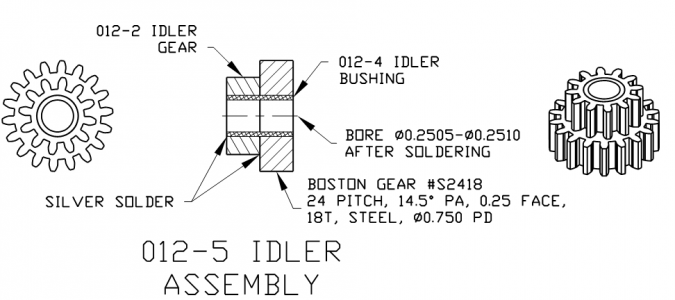- Joined
- Mar 9, 2018
- Messages
- 465
Alright, it's a question that's been asked and answered before, but I'm going to ask it again here.
I'm working on building an Edwards Radial 5 engine and the plans call for silver soldering an assemblage of two steel gears and a bronze bush; see photo below.

I've never silver soldered anything before. Certainly open to giving it a try, but this part in particular seems 'easily ruinable' by a novice silver solderer. I'm afraid I'll get solder in all of the gear teeth and everywhere else.
The load on this part will be quite small -- all it does is spin on an idler shaft and turn a 'cam ring', which activates the poppet valves. The temperature will be essentially the operating temperature of the motor, probably a couple/few hundred F.
I've got some Loctite 603 Retaining Compound on hand. Would that do the trick in lieu of silver soldering? Would a different Loctite Retaining Compound work better (i.e., Loctite 620 - high-temp retaining compound)?
There doesn't seem to be enough 'meat' in the small gear to allow me to pin the two together. So it'd be all silver solder, or all Loctite.
I'm working on building an Edwards Radial 5 engine and the plans call for silver soldering an assemblage of two steel gears and a bronze bush; see photo below.

I've never silver soldered anything before. Certainly open to giving it a try, but this part in particular seems 'easily ruinable' by a novice silver solderer. I'm afraid I'll get solder in all of the gear teeth and everywhere else.
The load on this part will be quite small -- all it does is spin on an idler shaft and turn a 'cam ring', which activates the poppet valves. The temperature will be essentially the operating temperature of the motor, probably a couple/few hundred F.
I've got some Loctite 603 Retaining Compound on hand. Would that do the trick in lieu of silver soldering? Would a different Loctite Retaining Compound work better (i.e., Loctite 620 - high-temp retaining compound)?
There doesn't seem to be enough 'meat' in the small gear to allow me to pin the two together. So it'd be all silver solder, or all Loctite.

